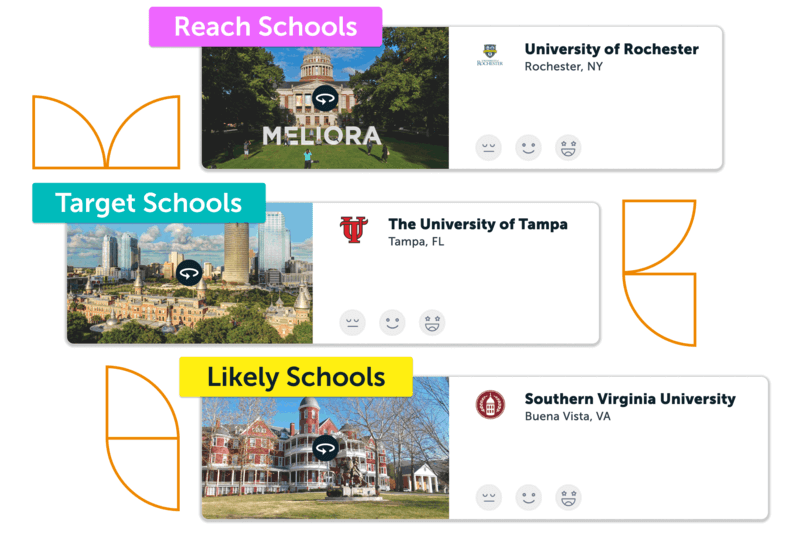Your List of Colleges: What Are Likely, Target, and Reach Schools?

Crafting your college list is one of the most important — and often stressful — parts of the college application process. But it doesn't have to be overwhelming. With the right structure, you can reduce uncertainty and make confident choices.
One proven method is to organize your list by Reach, Target, and Likely schools. These categories help ensure that no matter what happens during application season, you'll have great college options to choose from.
What Are Reach, Target, and Likely Colleges?
Reach, Target, and Likely are categories that help students strike a balance between ambition and practicality in the college admissions process. These categories are based on your academic profile, particularly your GPA and standardized test scores, compared to the school's typical range of admitted students.
| Category | Admission Odds | |
|---|---|---|
| Likely | Your academic credentials are stronger than the school’s average | 75%+ chance of acceptance |
| Target | Your academic credentials closely match the school’s average | 40–60% chance of acceptance |
| Reach | The school typically admits students with slightly stronger credentials | <25–30% chance of acceptance |
Tip: To determine where a college falls for you, compare your SAT or ACT scores and GPA to the school’s published admissions data. Use trusted college search platforms (like Appily.com) for accurate data.
What Is a Likely School?
A "likely school" (sometimes called a "safety school") is one where your GPA and test scores exceed the school's average profile of admitted students. These colleges still need to align with your other preferences — including size, location, campus culture, and degree programs.
Example scenario:
If you have a 3.8 GPA and a 1350 SAT, a college with an average GPA of 3.4 and average SAT of 1200 might be a Likely school for you.
Important: Don't apply to schools just because they're easier to get into. Your Likely schools should still offer strong academic programs and a campus experience you're excited about.
What Is a Target School?
A Target school is one where your academic profile aligns with the middle 50% of admitted students. You have a solid shot at being accepted, but admission isn't guaranteed, especially if the school is highly selective.
Example scenario:
If your GPA is 3.6 and your SAT is 1280, a college with a middle 50% SAT range of 1250–1350 would likely be a Target school.
Target schools should form the core of your list. These are colleges where you can thrive academically, socially, and professionally.
What Is a Reach School?
A Reach school is one where admitted students typically have slightly stronger academic profiles than yours, or where the acceptance rate is low due to high competition.
Important: Reach doesn't mean impossible. If your GPA and test scores are near the top of your range — or if you bring something unique to your application — you still have a chance.
Ivy League and ultra-selective colleges: These institutions are not just Reach schools; they're in a category of their own. Many students with perfect GPAs and test scores are denied due to extremely low admit rates. Treat these schools as additional applications outside your core list.
How Many Colleges Should You Apply To?
Most students apply to 7–9 colleges, balancing Reach, Target, and Likely schools to cover all possible outcomes.
Sample College List Structures
| Total Schools | Likely | Target | Reach |
|---|---|---|---|
| 7 | 2 | 3 | 2 |
| 8 | 3 | 3 | 2 |
| 9 | 3 | 4 | 2 |
Note: Some students apply to more than 10 schools, especially if they’re pursuing competitive majors or financial aid options. But applying to too many can stretch your time and resources. Quality over quantity.
How to Build Your College List Strategically
- Start with research: Use trusted tools like Appily's College Search to find admissions data, program offerings, and campus fit.
- Review your transcript and scores: Know exactly where you stand.
- Categorize each school: Sort your list into Likely, Target, and Reach based on real data.
- Consider cost and aid: Make sure your Likely schools are also financially viable.
- Keep a spreadsheet: Track deadlines, application status, and admission requirements.
Real-Life Example: Building a Balanced College List
Sophia has a 3.7 GPA and a 1290 SAT. She wants to major in environmental science.
- Likely schools: Colleges where the average SAT is ~1150, strong science programs, and affordable cost
- Target schools: Colleges with a middle 50% SAT range of 1250–1350
- Reach schools: Schools like UC Davis or the University of Washington, with averages closer to 1350+
Sophia applies to 8 schools: 3 Likely, 3 Target, and 2 Reach, plus one Ivy League school as a bonus.
FAQs: Reach, Target, and Likely Schools
How many Reach schools should I apply to?
Most students apply to 2–3 Reach schools as part of a balanced list of schools. Focus on schools that excite you and where you meet most criteria, even if acceptance is competitive.
Should I apply to Ivy League schools?
Yes. If you're academically qualified and interested. However, Ivy League schools should be treated separately from your core Reach/Target/Likely list due to their extremely low admission rates.
What's the biggest mistake students make when building their college list?
Applying only to Reach schools or not including financial safety options. A strong college list always includes schools across all categories.
Final Thoughts
Building your college list takes time, but it's worth the effort. A balanced mix of Likely, Target, and Reach schools increases your chances of acceptance and gives you real choices when decisions arrive.
Begin by exploring schools that align with your profile, interests, and goals. Use Appily to research your options and build a list that's tailored to your needs.